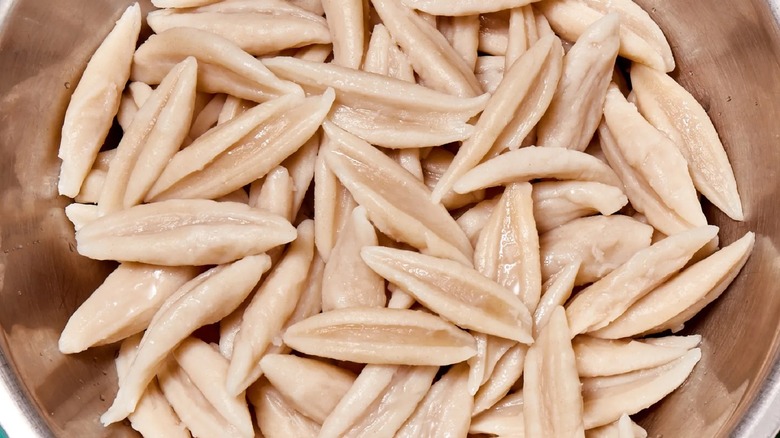The Hydration Ratio To Remember When Making Scissor-Cut Noodles
Scissor-cut noodles, which hail from the Shanxi province of China, are satisfyingly QQ (or chewy and bouncy) and beautifully al dente. They're also relatively easy to make at home, granted you remember this hydration ratio: Two parts flour to one part water. For a typical batch of scissor-cut noodles, you would mix about 300 grams of all-purpose flour with 150 grams of water. This ratio is the cornerstone of achieving the perfect noodle texture — just enough water to hydrate the flour, allowing the gluten networks to develop and strengthen. Too much water makes the dough sticky and causes it to lose structure and elasticity and become too difficult to cut with scissors. This two-to-one ratio is a perfect balance, ensuring the noodles have the right firmness, bounce, and elasticity, making them a favorite in Chinese cuisine.
While the basic scissor-cut noodle dough requires just flour and water, introducing miso or salt can add depth to the noodles' flavor profile. These additions, while optional, can enhance the overall taste without compromising the QQ texture. This basic noodle recipe does not need eggs or oil, keeping the dough simple and focused on the two primary ingredients.
A well hydrated and rested dough makes for bouncy and springy scissor-cut noodles
After you've mixed a two-to-one ratio of flour and water, the dough initially forms into a shaggy mass. This is your cue to begin kneading. Kneading helps the dough develop texture and structure. Then, it's crucial to allow this dough to rest. Resting the dough ensures that the flour is fully hydrated and the gluten develops adequately. Strong gluten networks in the dough will give your noodles their coveted springy, elastic, and bouncy texture.
This resting period, which can be as brief as around 15 minutes, not only improves the texture of the noodles but also eases your handling and cutting, which is crucial for creating the distinctive shape and feel of scissor-cut noodles. Perform a simple test to check if your dough is ready for cutting and cooking by simply pressing your thumb into the dough to make an indentation. If the dough is ready, it should quickly spring back, with the indentation disappearing. This indicates that the gluten has developed adequately, and the dough has suitable resilience to make scissor-cut noodles. Even if you're not a noodle-making guru or are new to the world of noodle-making, your chances of success with this dish are high. Just remember the fundamental two-to-one hydration ratio.

